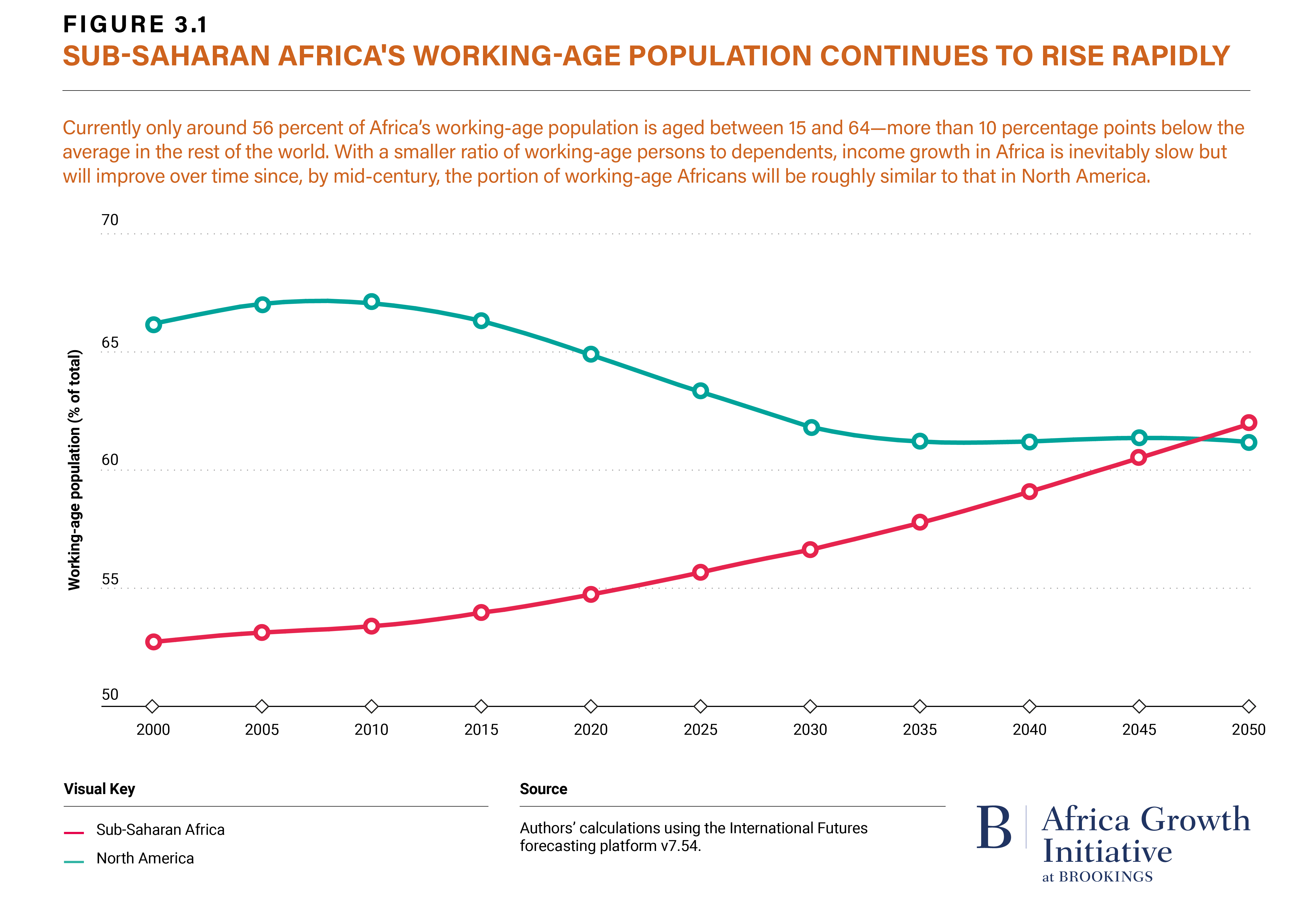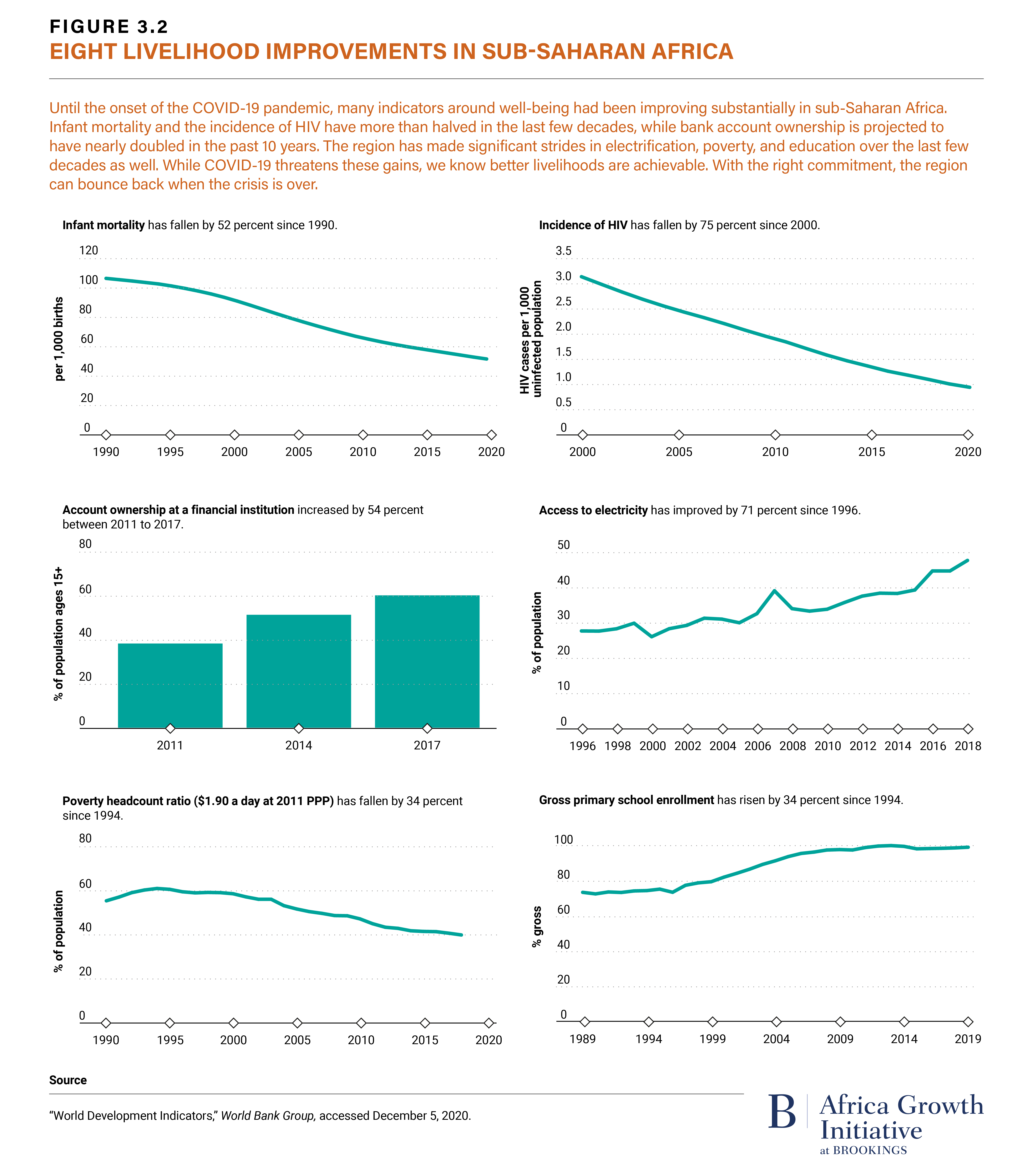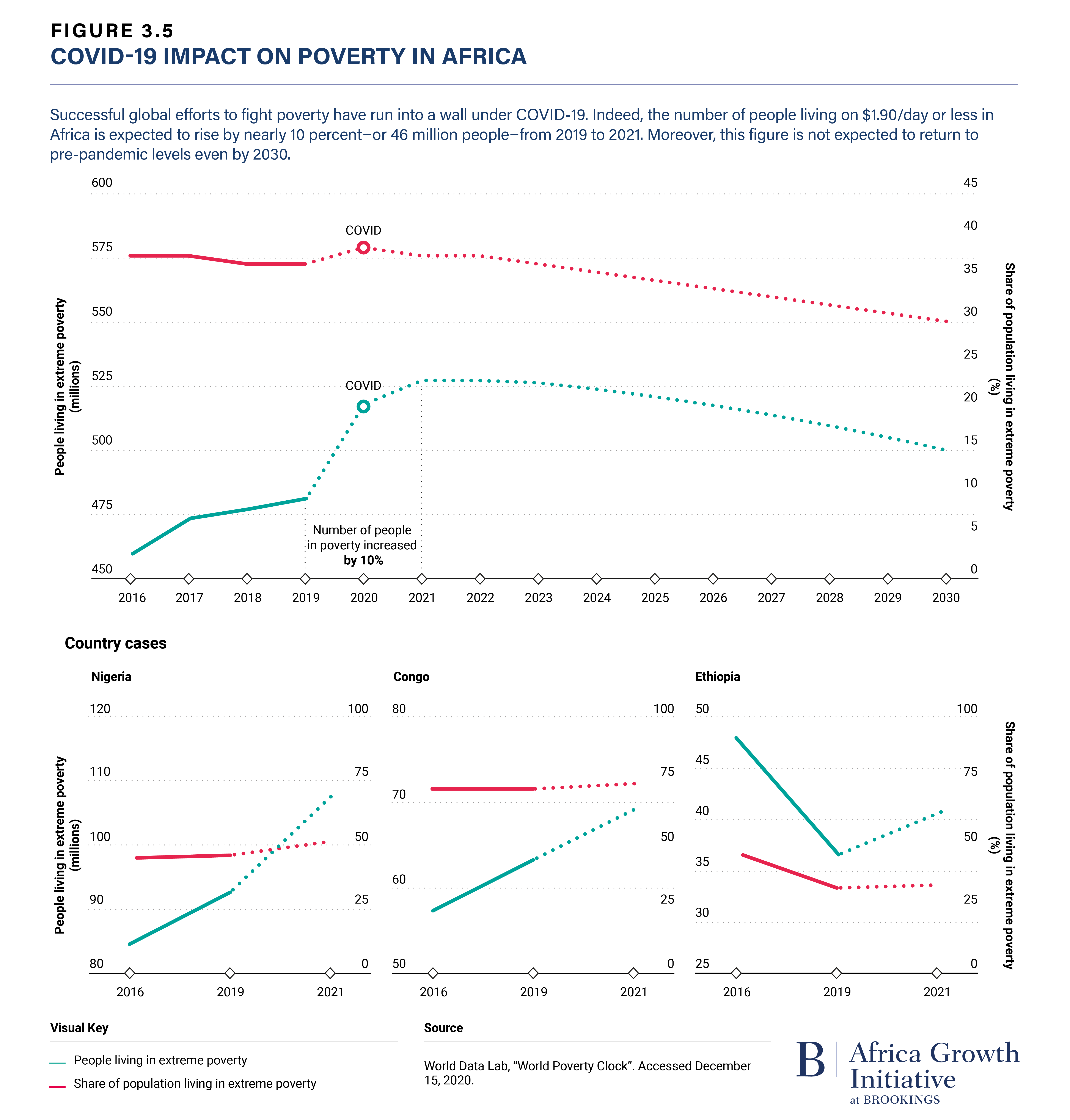03
Human development:
Protecting vulnerable populations
Strategies for preserving gains in human development in Africa in the time of COVID
Mortality in Africa due to COVID-19 is significantly lower than originally expected, although with limited testing and poor reporting systems, we will likely never know the true numbers. However, it’s not yet time to celebrate: That realization must be tempered by the expectation that many more Africans will likely suffer due to the impacts that follow reductions in health and other government expenditure. As tax revenues decline on top of reductions in remittances, foreign direct investment, and possibly aid, the ability of African governments to maintain pre-COVID services will take a large hit in the short term. One devastating result is that indirect mortality in Africa, particularly among children below five years of age, could be double the direct mortality from COVID by 2030, given expected cutbacks to basic medical care and related interventions. (For more on the reach of the COVID-19 pandemic in sub-Saharan Africa, see Figure 2.1.)
“The pandemic has rapidly evolved from a health crisis to an all-encompassing economic quagmire.”
In fact, within a year of Africa’s first reported case in Egypt, COVID-19 has wreaked extraordinary destruction upon Africa’s development prospects. The pandemic has rapidly evolved from a health crisis to an all-encompassing economic quagmire with serious international ramifications.
Our estimates and that of others such as the World Bank are that Africa may lose up to a decade of developmental progress due to COVID-19, although a lot will depend on the early discovery, speedy manufacture, and efficient roll-out of vaccines as well as the subsequent rate of global economic recovery.
The continent is also going to require substantial debt relief, as even ahead of the crisis a number of states were already approaching debt distress. In fact, in November 2020, Zambia became the first country to default on its loan repayments; it’s possible many other countries will follow.
Poverty and inequality
Before the pandemic hit, the headline Sustainable Development Goal to eliminate extreme poverty by 2030 was already out of reach. Now, except for Cabo Verde, no country in sub-Saharan Africa is on track to eliminate extreme poverty by 2030, though, notably, Africa’s two high income countries, Seychelles and Mauritius, have already achieved this goal.
Using the International Futures forecasting platform of the University of Denver, we find it is reasonable to expect around 4 percent annual average economic growth for Africa post-COVID to 2030. In this future, extreme poverty is likely to decline by only about five percentage points and, by 2030, a third of the continent’s 1.7 billion people is still likely to survive on less than $1.90 per day. Slow growth and high inequality mean that sub-Saharan Africa is only likely to achieve the elimination of extreme poverty by mid-century.
With high rates of inequality, few of the benefits of economic growth trickle down in sub-Saharan Africa1, and, in the short term, the impact of COVID-19 will worsen the already skewed distribution of income. Furthermore, as incomes decline and government revenues shrink, it’s not unreasonable to consider that the region is set to face increased turbulence and lose many of the modest gains made in combatting violent extremism and ending conflicts in the Horn, Sahel, and Central Africa, among other places—placing additional pressure on governments, peacekeepers, and mediators.
The vital importance of infrastructure for education
Despite these challenges, with the right policies and implementation plans, the COVID-19 pandemic may present Africa with the opportunity to benefit from its large human capital endowment. Steady increases in Africa’s working age population, improved economic productivity, and enhanced job creation can turn the region into an economic powerhouse accompanied with improvements in quality of life more broadly.
Currently, only around 56 percent of Africa’s working-age population is aged between 15 and 64—more than 10 percentage points below the average in the rest of the world (Figure 3.1). With a smaller ratio of working-age persons to dependents, income growth in Africa is inevitably slow but will improve over time since, by mid-century, the portion of working-age Africans will be roughly similar to that in North America. If the region’s leaders invest in that human capital endowment, Africa could significantly benefit from the steady increase in the portion of working-age persons to dependents.

Reaping Africa’s demographic dividend presents many challenges, but perhaps most fundamental is the need for a revolution in the provision of education. Quality education—especially improvement in the knowledge and skills of Africa’s rapidly growing labor force—is an absolute requirement for the continent to turn its fortunes around. The average adult African has about 6.2 years of education, some 2.5 years below the average in the rest of the world. While levels of adult education have steadily improved in Africa that gap has been constant for several decades.
“Among its many challenges, COVID-19 underlines the importance for Africa to focus on the provision of household electricity and internet access to respond to the damage caused by the pandemic.”
Among its many challenges, COVID-19 underlines the importance for Africa of focusing on the provision of household electricity and internet access to respond to the damage caused by the pandemic. In 2020, the digital divide condemned many African children to a lost year of education as parents were unable to compensate for out-of-school children through e-learning, since most neither have electricity nor stable internet access.
Even when children can access education in sub-Saharan Africa, the quality of that education remains far behind that in the rest of the world. Indeed, when it comes to learning outcomes, the best-performing country in the region still scores lower than the worst-performing country in Western Europe. It is, therefore, not surprising that the World Bank in 2018 warned of a “learning crisis in global education.”
If the continent is to start closing the gap on key human development indicators, it must seize the opportunity offered by technology to fundamentally change the provision of basic needs like education and health care as well as key infrastructure like electricity and the provision of the internet.

Indeed, consider that, in 2019, only about 57 percent of Africa’s population had access to electricity in contrast to about 88 percent in South Asia and well over 98 percent in Latin America. New technology, particularly the potential of distributed mini- and off-grid systems using renewables, could increase electricity access, while other, novel efforts such as low-earth satellites and similar initiatives could, within the foreseeable future, provide internet access across the entire continent.
The overriding lesson from COVID-19 is, therefore, to awaken African leadership to the importance of investing in the key enablers to speed up the extent to which the continent can leapfrog. At sufficient scale, technology can have a transformative effect. Africa must leverage modern technology to improve the provision of education, health care, and general economic inclusion and productivity.

Endnotes
- 1. North Africa, which has much lower levels of inequality, does significantly better in this respect, although it faces its own set of unique challenges.





